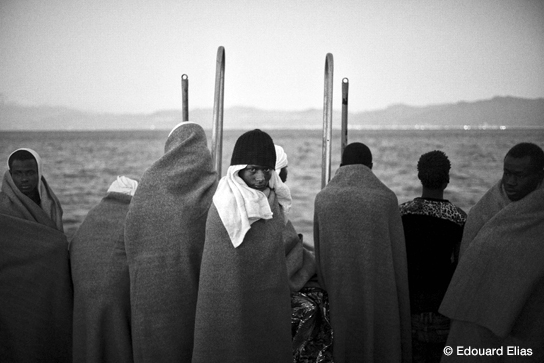
SOS Aquarius
Edouard Elias
Migratory routes leading to Europe are being closed one after the other. Walls around the Spanish enclaves in Morocco. An agreement between Europe and Turkey. Closing the borders to Greece’s neighbours. Barbed wire in Hungary, Macedonia and Bulgaria. A single road remains ‘open’: the most dangerous, the longest, the one known as the Strait of Sicily in the Mediterranean. Migrants embark from the beaches of Libya, sometimes Egypt, hoping to reach Italy. According to the International Organization for Migration (IOM), at least 2,765 people have drowned between 1 January and 15 September 2017. Others, likely swallowed up by the Mediterranean, remain forever missing. In the same period, 129,126 people were saved and arrived in Italy. Their crafts are white, 10-metre-long lifeboats. Fragile, they aren’t seaworthy and buckle under the number of passengers - 120, 130 - and split in half. Immigrants leave without water and food, with just a few oil tanks and often a cell phone to call emergency services. They have no chance of reaching Lampedusa by their own means. Launched in June 2015, the European military operation Sophia aims to monitor and identify boats. The ships involved save lives, even though it’s not their main mission. In parallel, NGOs have chartered their own boats, and their sole mission is to save the shipwrecked.
The photographs on display were captured by Édouard Elias and taken on board one of these ships, the Aquarius, chartered by SOS Méditerranée in March and April 2016.
Édouard Elias spent a part of his childhood in Egypt before going back to France for school. Brought up on documents and historical accounts from his grandparents, he left business school to start a career in photography, hoping to become a photojournalist. In the summer of 2012, while in Turkey to photograph Syrian refugees, he accepted an offer to set off with other journalists to Aleppo, during the rebel offensive to capture the city. His pictures were noticed at the Visa pour L’image festival, and photographer Patrick Chauvel helped him sell his first subject. Since then, he has continued to photograph for the press and exhibit his work. His main works until now have been Syria (2012-2013), the Foreign Legion (Central African Republic 2014 - Nîmes 2015), the migrant crisis in the Mediterranean (2016) and Mosul firefighters (2017). The timeliness of his subjects evolves over time, and framing, composition, and the photographic tool as well have helped him explore other ways of recounting how humans are confronted with their environment through isolation, war and suffering.